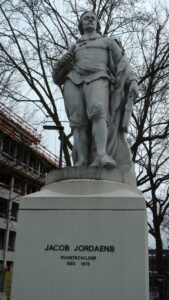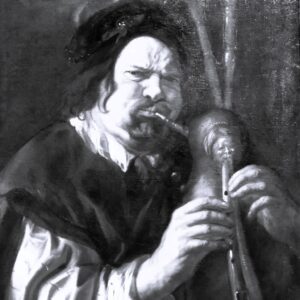The Riverside: Statue of Jacques Jordaens

In the 1615-1616 season Jordaens obtained his registration as master craftsman in the Liggeren (the ledger) of the guild of Saint Luke. He got the qualification of “water-painter”, after an apprenticeship of seven years.
Jordaens talks:
What did I look like in real life? Like most painters at the time, I portrayed myself. Just like a selfie today. Sometimes we stood as a model for a theme; as for me, I often painted myself together with my family.
If you have some spare time, visit the Royal Museum of Fine Arts, where a painting of a ‘Bagpipe player’ hangs in room 2.10. The round face and furrowed features of the player should convince you that it is the same man who’s standing here as a statue.
By the way, the musical instrument I play in the painting also tells you that I am fond of illustrating the life of the common people. Even in themes of ancient mythology, I incorporated portraits of people living around me.
I must also admit that me and my studio often repeated popular themes. Sometimes, this generated disputes: for instance, on August 25, 1648, I formally declared before a notary that I had personally painted five works of two years earlier. But I also had to confess that all five of them showed exactly the same subject and that I had the original paintings copied ‑ ‘So d’ouden songen/As the elder sing’ being one of them. But, a big but, afterwards I had them thoroughly modified and single-handedly painted them over. So I claim these to be original works.
Let’s return to the here and now; may I offer you some advice about statues like mine? It usually pays to have a look at the base or the back of the monument . Then you can learn something about the history of the monument itself. On the plaque at the base you’ll read that my first location was on Van Bréestraat, from 1886 to 1901. Then I was moved to Gemeenteplaats (today’s Franklin Roosevelt Square); Anthony Van Dyck was my neighbour there! That reminds me of our younger years (I am 6 years older than Anthony), when both of us worked together with our great master Pietro Pauolo Rubens, when we painted the ‘Rosary Cycle’ of St. Paul’s Church. Later, like it happened for our artistic careers, our statues went their own way.
Anthony followed our master’s advice and went to Italy, to perfect himself. Later on, he often travelled to England! My other esteemed teacher and father-in-law, Adam Van Noort, had also travelled to Italy. Aren’t today’s art and science students doing exactly the same thing, travelling throughout Europe, following the Erasmus programme?
I myself stayed in Antwerp; my travels were more business-oriented, to collect work orders in the Republic of the United Seven Provinces for instance.
Have you noticed that the sculptor Jules Pecher has depicted me with my left hand resting on a book? Or better, I should call it “The Book“, or for Christians: the Bible. It is for Protestants, even more so than for Catholics, the only authoritative reference for their religious life. It is true, I married my dearest Catharina Van Noort in the catholic Cathedral of Our Lady on May 15, 1616, but later on I was more and attracted by the ideas of the Reformation.
In the 1650-ies, my sympathy for Protestantism resulted in a fined of more than 200 pounds, a hefty sum (today at 100,000 euros!), for “scandalous writings“. About twenty years later, in 1671, our family was accepted as member of the congregation of the Mount of Olives in Brabant, which followed the strict protestant line of Calvinism. This community was not allowed to have public church services. That’s why I made our spacious house available to celebrate the Lord’s Supper around Christmas and Easter. The name of the same reformed congregation is now visible on Lange Winkelstraat in Antwerp.
As a consequence I do not want to be buried in a Roman Catholic church, but I would prefer my body to be taken to Putte, just across the border in Holland. And if one chooses to erect a memorial for me, let it be located there. As a matter of fact: that is exactly what they did, on the Antwerpsestraat of all places, near house number 32, 400 feet away from the ceasefire line of 1609/1648 between the northern and southern Low Countries. The bronze head over there, made by the Antwerp artist Jef Lambeaux, dates from 1877; that is even 9 years before the erection of the marble statue that speaks to you here!
Route South: continue until the next intersection, at the beginning of the Kloosterstraat; you look in the direction of the Royal Museum of Fine Arts.

